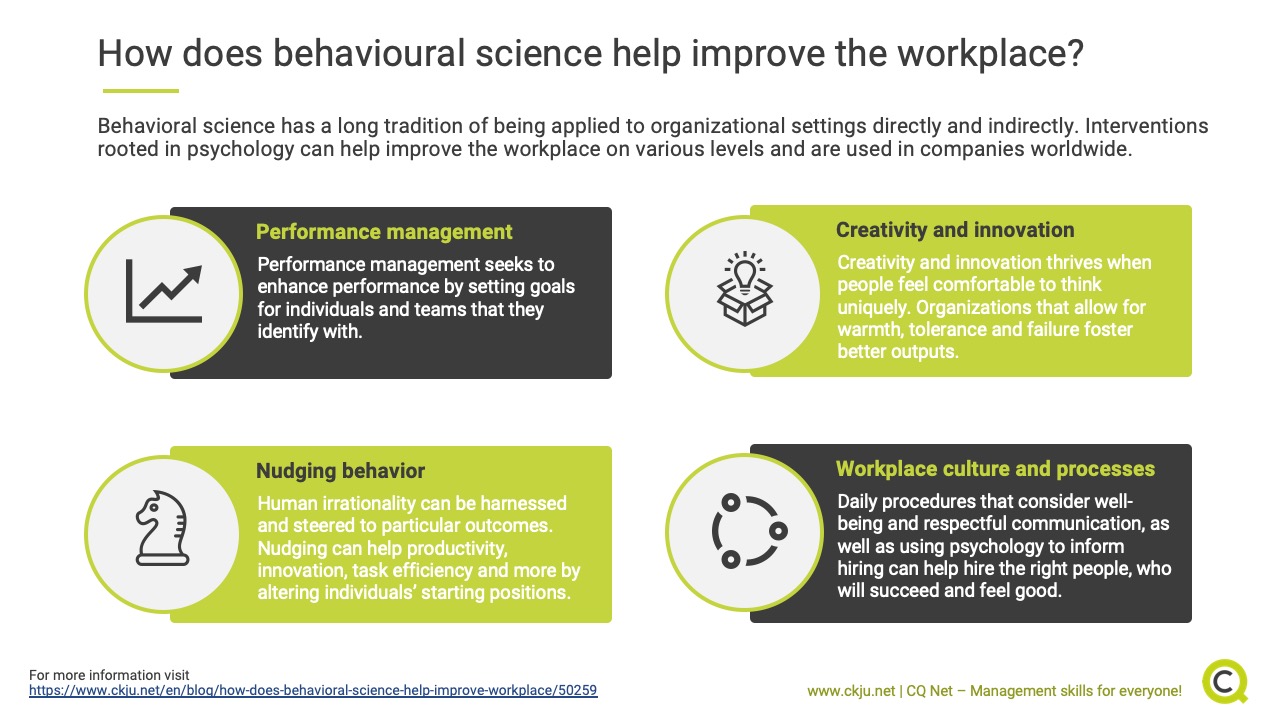- Blog
- Behavioral science workplace improvement
Contents
- Behavioral science principles are used directly and indirectly at the workplace
- Effective performance management is rooted in behavioral science and psychology
- Promoting or stifling creativity and innovation is a deeply psychological intervention
- Human irrationality can be used to indirectly encourage certain behaviors
- Behavioral science principles often inform daily procedures in the organizational environment
- Humans, their behaviors and their needs are the foundation of organizations
- References & further reading
Indeed, there is a very long history of using behavioral science in organizational and business settings – in particular, industrial and organizational psychology is an obvious example of an entire academic discipline dedicated to investigating the relationship between psychology and the workplace. But also in practical terms, behavioral science has long been the basis of many common HR practices. Psychological and behavioral principles generally often tend to be embedded very deeply into organizational structure and culture, and hence are often inadvertently made use of in almost all organizations in one way or another.
Behavioral science principles are used directly and indirectly at the workplace
There are several concrete applications within which psychological concepts are particularly relevant and are even common practice. These applications are both on the level of organizational practice and routines, as well as on the level of organizational culture. Very often, behavioral or psychological practices have to do with the relationship HR or leadership fosters to employees. In particular, there are three broad areas where behavioral science principles are particularly common:
- performance management,
- fostering creativity and innovation, and
- nudging management, among others.
However, there are also more punctual applications that anchor behavioral principles in overall workplace culture, relating to a healthy and constructive overall culture, fair procedures, and good communication.
Management skills newsletter
Join our monthly newsletter to receive management tips, tricks and insights directly into your inbox!
Effective performance management is rooted in behavioral science and psychology
One of the prime areas of application of behavioral and psychological principles in HR is performance management – it is used in almost any organization globally. An effective performance management system ensures that there is a continuous process of performance enhancement, which is achieved through setting individual and team goals that are aligned with the strategic goals of an organization.
The theoretical foundation for performance management through psychology is Goal Setting Theory (Locke & Latham, 1990). Goal-setting theory builds on the premise that individuals will do well if they set difficult goals for themselves, rather than following generalist advice like “do your best”.
There is a vast amount of empirical evidence suggesting that goal setting indeed improves performance, hence organizations globally tend to use this theory in the context of goal agreements (see Erez, Earley & Hulin, 1985 Deci et al., 1989). Such agreements are part of management incentive schemes and link rewards and behavior, thereby touching on innate psychological concepts. However, the newest psychological research has given rise to a new discussion on whether such plans, which focus on individuals and (financial) incentives, should also consider the role of team and company-specific goals.
Promoting or stifling creativity and innovation is a deeply psychological intervention
The second area in which psychological principles are regularly used in HR is when it comes to creativity and innovation. Innovation is a deeply psychological concept and is defined, first and foremost, as being borne from unique thinking (Randel & Jaussi, 2017). There are several factors related to psychology that promote innovation and creativity, including organizational warmth, tolerance for failure and ambiguity, and a long-term, future-oriented orientation in an organization.
In other words, creativity and innovation can be stimulated effectively by focusing on improving these characteristics within organizational contexts. There is ample evidence backing this up, which also suggests that it is actually immensely beneficial to adopt and encourage a future-focused orientation that encourages innovation on the long-term (Ozkaya et al, 2015).
At the same time, there are several organizational features rooted in psychology that kill employee creativity, including workplace hostility, rigid hierarchies, status symbols that reinforce these hierarchies (dress codes, job titles), as well as timely pressure to submit short-term results (See Ashkenas et al, 2015; Oreg & Berson, 2015).
Human irrationality can be used to indirectly encourage certain behaviors
The third area of application is on the micro level and is finding increasing popularity in organizations worldwide, despite finding its origins in behavioral economics. Nudging broadly refers to a method of steering behavior in an intended direction by using subtle shoves, rooted in an understanding and “hacking” of irrational, emotional and intuitive human behavior (see Thaler & Sunstein, 2008).
By default, insights are deeply rooted in an understanding of human psychology. For example, unappealing pictures on cigarette packages are meant to deter buyers whereas a default side-order of salad accompanying a buyer is meant to stimulate automatic, healthier choices.
In the realm of business, nudging is applied in so-called ‘nudging management’ (Ebert & Freibichler, 2017). Nudging management promises to help productivity in organizations by altering the way information is provided and used in the workplace. For example,
- short meeting times tend to increase productivity;
- kitchens or relaxation areas encourage communication and knowledge sharing, which in turn helps creativity and innovation;
- task efficiency can be improved by introducing ‘no-meeting’ days, where work is not interrupted.
However simple, resource-efficient and efficient nudging may be, it is a dangerous concept if applied wrongly or with dubious intentions. Nudging opens a breadth of opportunity for deceit, peoples’ behavior is unpredictable, and it is by no means a one-size-fits-all solution.
Behavioral science principles often inform daily procedures in the organizational environment
Beyond these three major areas listed in which behavioral and psychological principles often (inadvertently) appear and play a vital role, there are also several related smaller elements that characterize the workplace. As previously mentioned, psychological principles are often at the root of common practices of successful businesses without decidedly referring to or purposefully invoking decidedly psychological or behavioral principles.
Fostering well-being builds on understanding the human psyche and human needs
For example, research on well-being at the workplace shows that making an organization psychologically nourishing has positive effects on satisfaction, which in turn impacts performance. Consistently acknowledging and accommodating mental health needs (Goetzel et al, 2002), and understanding that every worker can benefit from the provision of mental health resources and interventions (Hurley et al., 2016) is vital to create a healthy and safe environment. Ideas include forming social groups to foster a sense of community, addressing conflicts with compassion and care, and providing access to quiet places to recharge.
Communication free of judgement makes for good organizational functioning
Nobody likes to be judged. Research has shown that organizational learning is much more likely to take place in an environment where communication is open and free of judgement (see Macedo, Porém, & Andrelo, 2014). This is particularly important for innovation and growth, as employees can be sure their ideas and thoughts are valued in an open way. When it comes to giving responses or even feedback, behavioral principles inform an effective feedback system embedded into organizational context. Such a system favors open, clear, straightforward and individual feedback (see DeNisi & Murphy, 2017).
Assessing potential employees with psychological models helps predict performance
It is well-established that personality traits can help predict job performance. One of the most commonly used selection and recruitment procedures is the so-called Five Factor Model of Personality. Costa and McRae (1992) outlined five factors that act as a model for selection and recruitment: emotional stability, extraversion, openness to experience, conscientiousness, and agreeableness. There is overwhelming evidence showing that utilizing these traits as a framework for onboarding helps employ people with a high chance of succeeding.
Humans, their behaviors and their needs are the foundation of organizations
This blogpost has shown that behavioral and psychological principles are often at the root of common practices of successful businesses. Very often, organizations implement and invoke such insights without decidedly referring to or purposefully invoking psychological or behavioral principles. Yet, there are plenty of applications in regular organizational practice across the globe that are likely to seem familiar to the average employee that all start from a basic interest in and understanding of human nature.
Indeed, organizations are nothing more than accumulations of people. Thus, making an effort to better understand, harness and benefit from implementing behavioral and psychological insights can undoubtedly have a positive impact on the workplace experience as a whole – from the managerial level to HR to regular employee relations.
References & further reading
Ashkenas, R., Ulrich, D., Jick, T., & Kerr, S. (2015). The boundaryless organization: Breaking the chains of organizational structure. John Wiley & Sons.
Costa, P. T., & McCrae, R. R. (1992). Normal personality assessment in clinical practice: The NEO Personality Inventory. Psychological Assessment, 4(1), 5-13.
Deci, E. L., Connell, J. P., & Ryan, R. M. (1989). Self-determination in a work organization. Journal of Applied Psychology, 74, 4, 580-590.
DeNisi, A. S., & Murphy, K. R. (2017). Performance appraisal and performance management: 100 years of progress? Journal of Applied Psychology, 102(3), 421-433.
Ebert, P. and Freibichler, W. (2017). Nudge Management: applying behavioural science to increase knowledge worker productivity. Journal of Organization Design, Vol. 6 No. 4.
Erez, M., Earley, P. C., & Hulin, C. L. (1985). The impact of participation on goal acceptance and performance: A two-step model. Academy of Management Journal, 28(1), 50-66.
expand
Locke, E. A., & Latham, G. P. (1990). A theory of goal setting & task performance. Englewood Cliffs, N.J: Prentice Hall.
Macedo, A.M., Eugêni, M.E., & Andrelo, R. (2014). Organizational communication and innovation in micro and small companies: a study on the application of the “Innovation Radar.” Comunicação e Sociedade, 26, 136-161.
Oreg, S., & Berson, Y. (2015). Personality and charismatic leadership in context: The moderating role of situational stress. Personnel Psychology, 68(1), 49-77.
Ozkaya, H. E., Droge, C., Hult, G. T. M., Calantone, R., & Ozkaya, E. (2015). Market orientation, knowledge competence, and innovation. International Journal of Research in Marketing, 32(3), 309-318.
Randel, A. E., & Jaussi, K. S. (2017). Leading for uniqueness: The role of uniqueness in facilitating creativity in employees’ self-concepts. In The Creative Self (pp. 289-299).
Thaler, R. H., & Sunstein, C. R. (2008). Nudge: Improving Decisions About Health, Wealth and Happiness. London: Penguin.
Top Rated
About the Author

Comments
Most Read Articles
Blog Categories
RELATED SERVICES










Add comment